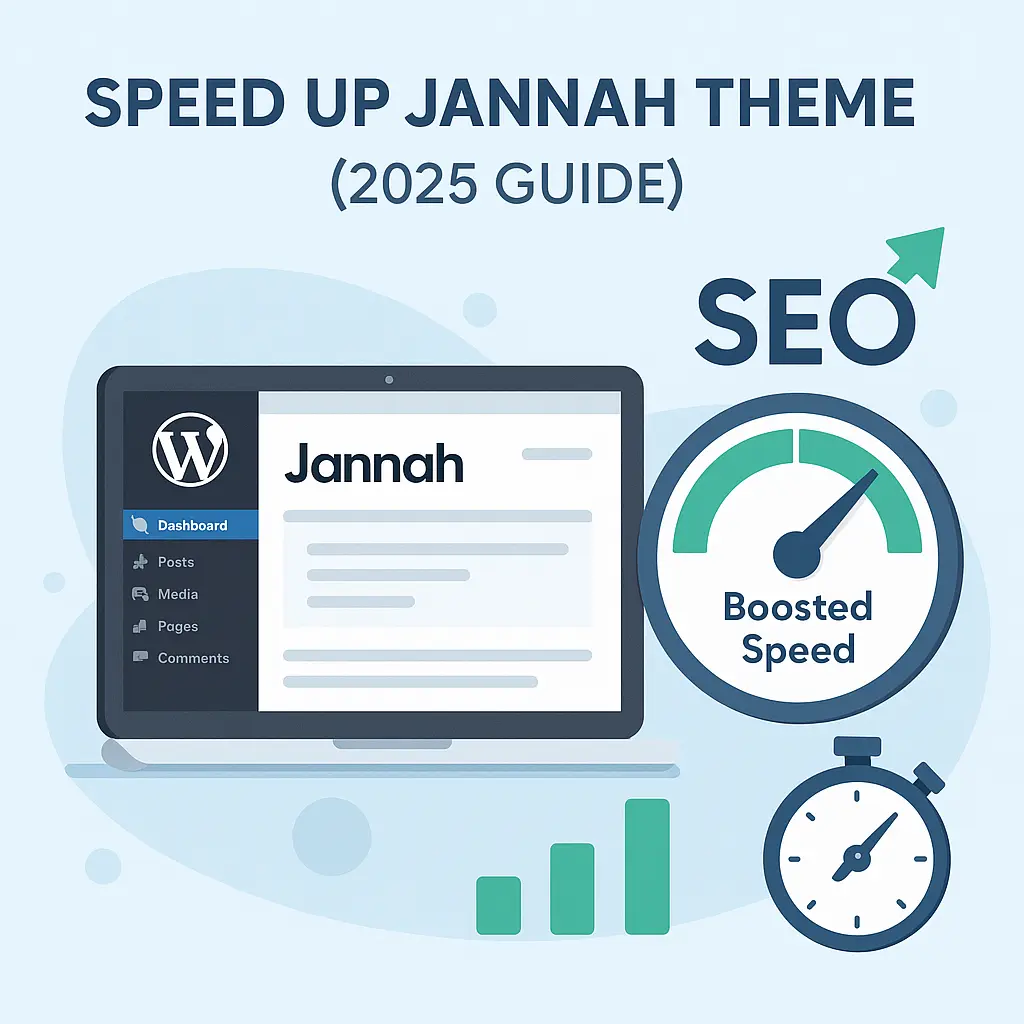You’re not the only one who thinks that your WordPress site that uses the Jannah theme is slow. Jannah has a lot of powerful capabilities, but if you don’t optimize it properly, it can slow down. In 2025, site performance is more important than ever for both search rankings and user experience.
This tutorial will show you simple and efficient ways to make your Jannah-powered website load faster, improve your SEO, and keep your visitors satisfied. You don’t have to be a programmer to make these modifications. This post can help you get better performance without giving up design, whether you have a blog, an online magazine, or a site with a lot of information.
Let’s go to work and make your Jannah site work the way it should: quickly and with good SEO.
Why speed is important in 2025
Google’s Core Web Vitals are still very important in 2025. If your site is slow, you could lose traffic, rankings, and sales. If a page takes even one second longer to load, people will leave, especially on mobile. The Jannah theme has a lot of material and often a lot of media, thus it can slow down if it isn’t set up well.
People who visit your blog or news site expect pages to load quickly. Also, Google gives sites that load quickly better prominence. It’s not just about performance; speeding up your Jannah theme is also important for SEO.
Step 1: Get the Most Recent Version of Jannah
The Jannah theme gets regular updates to make it faster, solve issues, and keep up with the current WordPress standards. Always keep your software up to date. The most recent version is Jannah 6.x (as of mid-2025).
Steps to update:
- Navigate to Dashboard > Updates.
- Look for any updates to the theme.
- You can update your Jannah theme from there.
💡 Tip:
Make a backup of your site before updating to avoid problems.
Step 2: Web Image Optimization
Jannah sites are frequently associated with sluggish loading times due to the presence of images. The theme is made for gorgeous layouts, however images that aren’t compressed can slow things down.
To fix it, do this:
- Using AVIF or WebP image formats
- Using plug-ins like ShortPixel or Smush to shrink pictures
- Setting up lazy load (This is supported by Jannah.)
Suggested settings for images:
- Maximum width: 1200px
- Format: WebP
- Compression: Lossy (to keep things balanced)
💡 Tip:
Don’t upload pictures directly from your camera or phone. First, compress them with tools like Squoosh.
Step 3: Get rid of widgets and features you don’t use.
Jannah provides a variety of built-in tools, like ad blocks, social counters, weather, and breaking news tickers. They still add weight to your site even if you don’t use them.
Disable these things:
- Breaking News bar (if not in use)
- Megamenus with pictures
- Sticky sidebars
- More social networks for sharing
How to turn off:
- Go to Theme Panel > Features and switch off the things you don’t need.
💡 Tip:
The less stuff you have on your homepage, the faster it loads. Make sure everything stays clean.
Step 4: If you want to customize, use a lightweight child theme.
Do you need to update the CSS or layout? Don’t put too much on your core theme. You can make changes to your site without slowing it down by using a child theme.
Why it matters:
- Keeps important Jannah files clean
- Helps with updates in the future
- Debugging is easier
You can make one yourself or use a plugin like Child Theme Configurator.
Step 5: Choosing the Right Hosting
A slow host might slow down your site, even if you have the best settings. It could be time to upgrade if you share hosting.
Tips for hosting:
- Choose SSD/NVMe hosting to speed up reading and writing.
- Use servers like LiteSpeed or NGINX.
- Don’t use shared plans that are too loaded.
Step 6: Install a Caching Plugin.
Caching makes it easier for your site to serve static files to visitors, which speeds up load times.
The Jannah motif goes well with:
- LiteSpeed Cache (if your server is LiteSpeed)
- WP Rocket (premium, but effective)
- W3 Total Cache (free with advanced settings)
💡Tip:
In the options for your plugin, turn on GZIP compression, page caching, and browser caching.
Step 7: Minify HTML, CSS, and JS
Minifying makes code files smaller and faster to load by getting rid of extra characters.
One-click minification is a feature of most caching plugins, such as WP Rocket or LiteSpeed Cache.
If not, try:
- Autoptimize
- Asset CleanUp
💡Tip:
Don’t over-optimize, though. After you turn on these options, test your site to make sure nothing looks broken.
Step 8: Use a CDN (Content Delivery Network)
A CDN helps deliver your content from the place that is nearest to your visitor. If your traffic comes from other countries, this is really helpful.
Some popular choices are:
- Cloudflare is free and works well.
- BunnyCDN (cheap and fast)
💡Tip:
Use a CDN and caching together for the greatest results.
Step 9: Delay JavaScript and load scripts at different times
By default, Jannah loads some JavaScript files for advertisements, sliders, and carousels. You can speed up the first render by making them wait to load.
How to do this:
- In WP Rocket or LiteSpeed Cache, turn on “Defer JS.”
- Choose “Defer and Async” in Autoptimize
💡Tip:
After turning it on, use PageSpeed Insights to test your site.
10. Make sure your database is clean.
Your database acquires rubbish over time, such changes, spam comments, and entries that have been deleted.
You can use plugins like:
- WP-Optimize
- Advanced Database Cleaner
To keep your site functioning smoothly, set up weekly cleanups.
Step 11: Turn off Google Fonts (or host them locally)
If improperly optimized, Google fonts might make pages take longer to load. Either:
- Use the OMGF plugin to host fonts on your own server.
- Or pick fonts for the system
💡Tip:
Pages load more quickly when minimalist typography is employed.
Step 12: Test your website.
After all the modifications are made, check how well you do by using:
- GTmetrix
- PageSpeed Insights
- Pingdom Tools
Aim for:
- LCP under 2.5s
- FCP under 1.5s
- Page size under 2MB
- Requests under 100
Bonus: The best Jannah theme settings for speed (2025)
In Theme Panel > Performance, turn on the following:
- Lazy load images
- Minify CSS & JS
- Combine files (if compatible)
- Disable Emojis
- Disable Embeds
Want Help Optimizing Jannah?
Making your site faster might be hard. We’re here to help if you’d prefer have a professional do it.
We help bloggers, businesses, and news sites make their WordPress sites quick, SEO-friendly, and mobile-friendly at Preet Web Vision.
📞 Contact us: +63-9633112000
📧 Email: hello@preetwebvision.com
🌐 Website: Preet Web Vision
Learn More: Watch Tutorials
📺 Subscribe for WordPress, SEO & Digital Marketing Tutorials:
- Preet Tech Ideas (English)
- Preet WebXP (Hindi)
Get video guides that show you how to solve site performance, increase SEO, and make your online presence better.
In conclusion,
It doesn’t have to be hard to make the Jannah theme better. You can make your site faster and get a higher ranking in Google in 2025 if you use the appropriate settings, plugins, and tools. Not only can fast-loading websites help with SEO, but they also make your readers happy.
💬 Do you have any questions or advice to share? Please leave a remark below with your opinions; we’d love to hear from you!

